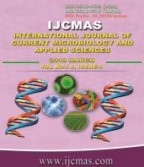


 National Academy of Agricultural Sciences (NAAS)
National Academy of Agricultural Sciences (NAAS)

|
PRINT ISSN : 2319-7692
Online ISSN : 2319-7706 Issues : 12 per year Publisher : Excellent Publishers Email : editorijcmas@gmail.com / submit@ijcmas.com Editor-in-chief: Dr.M.Prakash Index Copernicus ICV 2018: 95.39 NAAS RATING 2020: 5.38 |
A new “Green revolution” is needed in world agriculture to increase crop yields for food and bioenergy, because gains from conventional breeding method are less than world population growth. Efforts to increase crop productivity must also consider global change. Carbon-dioxide, methane and other greenhouse gases in atmosphere leads to global warming. Photosynthesis is the single most effective natural regulator of carbon dioxide in the Earth’s atmosphere. It is timely to consider what new opportunities exist in the current “omics” era to engineer increases in photosynthesis. Significant enhancement of photosynthesis in several C3 plants like rice, wheat and potato occurs due to insertion of C4 genes into C3 plants. It has been suggested that the C4 pathway evolved from C3 ancestors as an adaptation to high light intensities, high temperatures, and dryness. The C4 plants have several important characteristics such as high photosynthetic rates, high growth rates, low rates of water loss and a specialized leaf structure, high yields and water & nitrogen-use efficiencies, by concentrating CO2 around Rubisco, C4 plants drastically reduce photorespiration and concentration Of CO2 to the vicinity of Rubisco in C4 plants favours the carboxylation of RuBP over its oxygenation. There are three major strategies to improve the photosynthetic efficiency of C3 plants, such as Improving the quality and quantity of rubisco, Increasing thermotolerance of Rubisco Activase, Increasing Co2 concentration around Rubisco to enhance catalytic rate of Rubisco and to minimize the photorespiration and Over expression of C4 genes.
 |
 |
 |
 |
 |